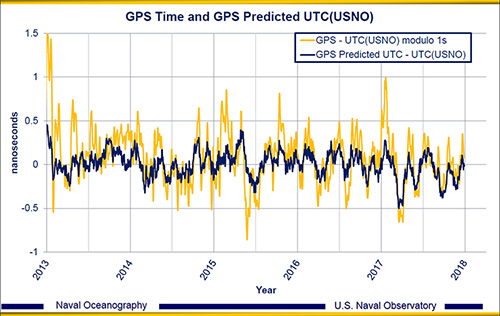Timing Accuracy

Within 1.5 ns of Each Other
GPS and UTC Time Transfer Specifications - How They are Stated and What They Mean
The Global Positioning System (GPS) is the premiere means of disseminating Coordinated Universal Time (UTC) to the world, but the underlying time base for the system is actually called GPS time. GPS time is derived from an ensemble of cesium beam and rubidium atomic clocks in the satellites, ground and control stations, and is steered to the UTC time scale maintained at the United States Naval Observatory (USNO) in Washington, D.C. USNO also monitors the satellites on a daily basis with specialized GPS reference receivers that measure the clock offset to UTC(USNO). Using these measurements, corrections are computed for the GPS time scale, satellite clocks, UTC-GPS time offset, and then sent to the GPS Master Control Station for system-wide upload. This process results in a worldwide, traceable, UTC time transfer system with extraordinary accuracy.
UTC Time Transfer Accuracy via GPS
In the beginning of the GPS project, it was not known how well the GPS time scale could be synchronized to UTC(USNO). Therefore, GPS time was conservatively specified to be within one microsecond of UTC(USNO) and continues to be today in IS-GPS-200H. The accuracy of the broadcast correction to GPS time to yield UTC is specified at 97 nanoseconds (1 sigma). Through various modernization efforts to the space, ground and control segments, the GPS time offset and the accuracy of the broadcast UTC correction have been significantly improved.
GPS performance standards are in place today, per the 2008 Standard (SPS) and Precision (PPS) Positioning Service Performance Standards, that complement IS-GPS-200. These standards establish minimum levels of GPS system performance mandated by U.S. law (10 U.S.C. 2281(b)). Per the standard, normal GPS system operations must ensure the UTC offset data broadcast by GPS is within 40 nanoseconds 95% (20 nanoseconds 1 sigma) to UTC(USNO).
This performance standard far exceeds the IS-GPS-200H specification but is well within the capabilities of the GPS system. Between 2005 and 2015, the difference between the UTC(USNO) and GPS time scales, as measured by USNO, was less than 10 nanoseconds RMS. When the broadcast UTC offset data was applied, UTC time derived from GPS was impressively within 2 nanoseconds RMS to UTC(USNO) during this period.
Our Philosophy
GPS has over-achieved its original goals in almost every way - including reliability, satellite life expectancies, and PNT performance. Modernization continues to improve performance and time transfer accuracy. The accuracy of GPS timing receivers and instruments, however, can only be guaranteed to the levels stated in the SPS Performance Standard.
At EndRun Technologies, we specify the time accuracy of our GPS instruments to UTC(USNO) based on the USNO measured UTC time transfer accuracy delivered by the GPS system over the last 10 years (< 2 nanoseconds RMS). We believe that by specifying our equipment this way, you can see that the accuracy to UTC of our GPS time and frequency standards is the best in the industry and allows you to realize the full performance available during normal operations of the GPS system.
